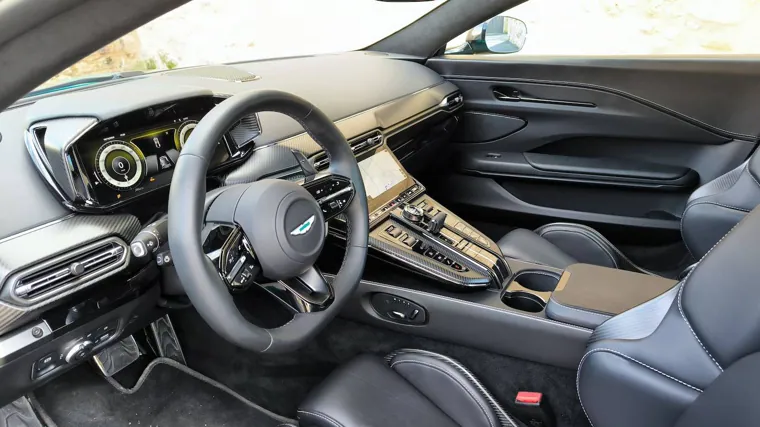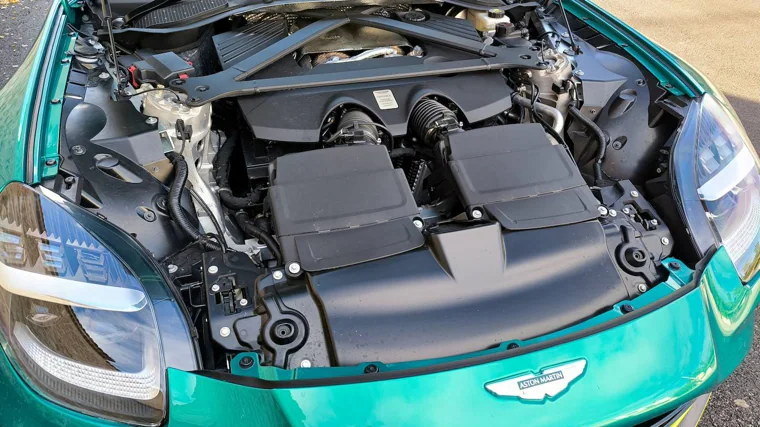The Vantage name continues a remarkable lineage dating back to 1950, when the name was first used to designate an upgraded engine package for the DB2 racing car. The first time the term “Vantage” was used to designate a model was in 1964, a high-performance version of the DB5, which became the new flagship of the range.
In 2005 Aston Martin presented the Vantage, now conceived as an entry-level model. In 2018 a second generation arrives and, in 2024, this Aston Martin has been updated, and it is not a facelift, it is much more. We can’t really call it “small” anymore, say those responsible for the brand. Indeed, the new Vantage boasts great figures: 665 HP. 800 Nm, accelerates from 0 to 100 km/h in 3.5 seconds and reaches a maximum speed of 325 km/h. And a starting price of euros that places this “little” Aston Martin in the clan of the “big ones.”
This is a nice, well-designed car that is not only a big improvement on the old Vantage, but also a great car. Before we drive it, let’s talk about the changes relative to the 2018 Vantage.
The front allows an airflow intake 25% higher than that of the previous Vantage, necessary due to its greater power
While the taillights and overall body shape remain unchanged, virtually every body panel has evolved. One of the first things that catches your eye are the new, larger headlights, which help visually balance the new and frankly gigantic grille. The latter is very voluminous, because the more muscular engine requires a large cooling capacity: up to 29% more fresh air enters. The new ventilation grilles located on each side are somewhat reminiscent of those of the old Aston Martin One-77. The new, very thick side skirts translate into a 30 mm increase in width. The front spoiler has also been redesigned.
The interior has received an even more complete overhaul. It is more modern, prettier, more pleasant to the touch and has a much more modern multimedia interface and screen; the same system found in the DB12 and redesigned DBX.

The cabin is also transfigured, with the same dashboard as in the DB12, materials to match and intuitive ergonomics around a Porsche-style center console.
Fortunately, there are still buttons, but better laid out than before, with tactile, textured knobs for the stereo volume, air conditioning fan, and temperature settings for the driver and passenger. The buttons also let you select adaptive damping or active exhaust modes, while the old separate P, N, D and R buttons have disappeared in favor of a traditional, more practical selector.
The dashboard is also better designed, with simpler lines. Although much of the interior is new, its driving position is the same as before: that of a front-engined sports car, low, with arms and feet extended.
Aston Martin has reinforced the structure of the Vantage in strategic places, and the torsional rigidity of the entire chassis has been increased. For example, the rear shock absorbers are attached behind the seats, additional protection panels have been added front and rear and a new design of the transverse engine mount has been developed.
In addition to giving Aston Martin engineers greater flexibility when choosing tires and shock absorbers, the goal was to achieve greater precision. The greater rigidity at the rear of the car improves the lateral load supported by the rear tires, as well as their reaction.
Another objective of reinforcing front rigidity was to obtain a better steering feel in the midpoint, which is not always easy to achieve with a sports tire. The Vantage now mounts the very sporty Michelin Pilot Sport 5 S tires
The electric power steering was revised and the steering column was redesigned to improve feel and response. Springs, bars and ball joints have been checked. Widened tracks also improve performance. And the new electronically controlled Bilstein DTX shock absorbers.
Braking has been improved with 410mm front discs and six-piston calipers. The rear ones are 360 mm, with four-piston calipers. A new brake booster provides a firmer, more communicative pedal response, and Aston Martin has even designed different servos depending on whether customers choose the standard cast iron brakes or the optional ceramic brakes (which are fitted to the cars we drive here). to get the best possible sensations. But Aston has put as much effort into making the new Vantage fun at normal highway speeds as it has into being precise and agile at high speeds.
The power of 665 HP (155 HP more than the old Vantage and 130 HP more than the more powerful F1 Edition) is an advantage. It allows the new Vantage to dominate in its segment and justify its price of 201,327 euros. Thus the Gaydon firm has clearly decided that all its cars must be the most powerful in their class. Thus, the new Vantage surpasses the Mercedes-AMG GT with which it shares its 4-liter biturbo V8 (585 HP in the Stuttgart model), the Ferrari Roma (powered by a 4-liter biturbo V8 with 620 HP) and even the Porsche 911 Turbo S (6-cylinder boxer, 3.7 liters and 650 HP).

The 655 HP V8 is in the front center position
The turbos, cylinder heads, cams, intake and exhaust valves – and even the block – are new compared to the previous Vantage. The ZF eight-speed torque converter automatic transmission remains the same, with redesigned elements and software tweaks for faster shifts. The ratios are the same, but shortening the final ratio by 5% has allowed acceleration to be increased. As before, the vehicle is equipped with an electronically controlled differential, now recalibrated.
There is something very special about getting behind the wheel of an Aston Martin. It is touching, listening, feeling the spirit of a brand born one hundred and eleven years ago, created by a driver called Lionel Martin, who ran tests at Aston Hill, with his partner Robert Bamford. Many races, with triumphs like Le Mans in 1959, a history with complicated moments, but always saved by the passion of daring people…
In the center/front position, the 4.0-liter biturbo V8 of Mercedes origin (the German brand is a technical partner of the British) emits a powerful car growl at idle, but is soft and docile at low speeds. The Vantage’s automatic transmission is slow when upshifting. If we want more speed, we have the paddles that have been moved from the steering column to the back of the steering wheel, and then we lock the gearbox in manual mode using the button located behind the gear selector.
On small roads you have the feeling of taking up a lot of space, but we quickly felt comfortable. The Vantage quickly gives you confidence: it is agile, balanced and, above all, the sensations behind the wheel are very clear.
There are five driving modes, selected by rotating the bezel surrounding the start button. Sport is the default mode, then there’s Sport+, Track, Individual to choose your own settings and a new Wet mode.
There is also an anti-slip system adjustable in nine positions: 1 corresponds to maximum traction, 8 allows great freedom of movement and 9 is completely deactivated.
When going from Wet mode to Sport the difference is very big, and even more so in Sport+, the firmest: here the suspension is really very rigid. In fact, from the first corner it gives the impression that it is also very firm in the default Sport mode. The damping at low and medium speeds is a little more responsive than you would expect.
However, this improves as speed is gained: the more you accelerate, the more the Vantage gains in flexibility and elasticity. We chose the Sport + driving mode, to slightly stiffen the shock absorbers and further strengthen the body support. When tackling the long corners, you feel the car sink slightly in the first phase of the corner, before settling down. The front grip is impressive and the rear grip follows beautifully.
Despite its enormous power, it is a more communicative and easier car to drive. You can feel exactly what is happening with your Pilot Sport S 5.
A button on the center console changes the exhaust sound in three stages, but even in silent mode, it can be heard inside: someone may get tired, but, personal opinion, I find it a real pleasure to listen to this eight-cylinder. And, from the outside, the sound is fantastic.
And while 665 horsepower may seem excessive on paper, it makes the Vantage a fantastic toy. The maximum torque of 800 Nm distributed between 2,750 and 6,000 rpm also plays an important role in the vehicle’s performance.

In the back, the 346-liter trunk, almost at the level of a good compact, but enough to surpass all supercars with a rear mid-engine
The new Vantage is a truly fun and desirable car, which you can choose based on its own qualities without having to compare it with the competition. Suspensions, brakes, steering, a 50/50 weight distribution… are factors that add fantastic sensations. In reality, one might wonder if this new Vantage has something to envy of its older brother the DB12…
It’s hard to get out of this car at the end of our test. More kilometers would be needed to get to know the Vantage in more depth, to really take advantage of all its potential, to continue enjoying a sports car that is, due to its balance in every sense, an irresistible seducer, like Bond, James Bond…, you know.
#Vantage #revolution #Aston #Martin


